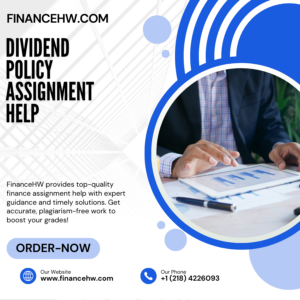How does dividend policy impact company valuation?
How does dividend policy impact company valuation? [Article 11] […] in America from “faster dividends” to “fast dividends”[…] An analysis
Dividend policies have an immediate and profound effect on their stock prices, Dividend Policy as reinvestment of earnings may help maximize wealth rather than dispersal among shareholders.
At Firm Valuation Assignment Help, you can identify clients with specific dividend payment preferences that would like either stable or gradually increasing dividend payments.
Free cash flow is an indispensable measure of a company’s financial health, showing whether there is enough cash available to meet debt service payments and expenses as well as invest in growth initiatives or research and development initiatives. A positive free cash flow figure may even allow for dividend payments or share buybacks that reward shareholders.
However, this metric has its limitations. For instance, it neglects that businesses typically finance capital expenditures with loans, FinanceHW which can distort free cash flow results. Furthermore, purchases made over multiple years will be deducted from free cash flow calculations, leading to overinvestment or overpaying acquisitions. This paper investigates these issues by estimating free cash flows to equity of firms from 2014-20 and discounting them back at their cost of capital; our analysis uses panel data from 110 listed companies on the Ho Chi Minh Stock Exchange from this period spanning 2014-20.

Under this approach, a company pays out a fixed dividend each year regardless of changes to earnings. This method is highly sought-after by conservative investors as it offers them a sense of security and predictability. When profits spike higher than anticipated, companies may save extra funds so as to maintain this stable rate for dividend payments.
Policy of this sort can be difficult to sustain, as it requires balancing investor expectations against investments necessary for future growth. If a company falls short in meeting investor demands, its performance could be punished by the market.
Gradual increases in dividend payments are beneficial to Shareholder returns and can help ensure short-term losses can be avoided by dissuading companies from spending cash on projects which won’t turn a profit, and providing discipline around profitability criteria for investment decisions – making this strategy ideal for consumer goods companies with consistent revenue streams.
Companies often follow a set pattern of dividend payments in order to maintain a steady pay-out ratio and appeal more strongly to income-oriented investors, like retirees. But this policy has its drawbacks if earnings dip: investors might interpret any decision to reduce or cancel dividend payments as signaling that its future may be uncertain.
This approach allows a company to retain some profits as retained earnings while dispersing the remainder as dividends to shareholders. Furthermore, this method also makes capital markets fundraising cheaper due to reduced issuance costs.
The free cash flow model of dividends asserts that companies should distribute any excess funds after investing them in Projects with positive net present value as dividends to clients who prefer stable or gradually increasing dividend payments. To gain further insights, avail firm valuation assignment help.
A dividend clientele refers to a group of investors that share similar views about a company’s dividend policy. Investors with such similar opinions tend to buy or sell stocks depending on their desired type of dividend payout; retiree investors often favor higher dividends as this helps ensure steady income from their investments; therefore any changes to its dividend policy could cause them to sell their stock and abandon this group of investors altogether.
The free cash flow theory of dividends asserts that firms should distribute any excess funds after investing in all available positive net present value projects, to shareholders with similar preferences. As evidenced by higher tax brackets trading away of companies increasing dividends. For more information about this concept take firm valuation assignment help.
Finance can be an intricate subject with its many intricate formulas and complex financial models, which makes understanding it challenging. Students often struggle with understanding these Concepts and applying them in their assignments – which is why PapersOwl provides finance homework help services for those needing an extra helping hand.
Make sure that when completing this assignment, your points are supported with evidence – this will help ensure a higher grade on your finance assignment.

A dividend policy provides details about a company’s intentions regarding how profits will be divided among shareholders. It indicates whether earnings will be retained or dispersed in order to balance shareholder rewards against long-term growth goals.
A successful dividend policy should be adaptable enough to respond to economic and business cycles while being firm enough to manage shareholder expectations. Furthermore, it serves as an effective communication channel between management and its shareholders who wish to learn about its financial health and potential growth plans.
Companies often decide to pay dividends without adopting an official dividend policy, particularly when they make a significant profit in one year and expect this level of performance to continue into subsequent ones. The decision is usually made by their board of directors after careful Analysis and discussion.
A dividend policy provides the blueprint for how a company plans to distribute profits among shareholders, outlining when, how much, and whether the payout will take the form of cash or additional shares.
Companies with a stable dividend policy provide investors with consistent income by offering fixed payouts that remain relatively constant over time, offering predictable returns that appeal to widows, retirees, and middle-class families who prioritize predictable returns.
Companies with a constant dividend policy tie their dividend payout directly to earnings, meaning as profits increase or decrease so will the payout. This type of policy can help businesses build investor trust and loyalty while showing financial discipline; however, such an approach could send mixed signals if earnings decline but directors opt to keep paying out regardless.
Companies employing a stable dividend policy distribute a fixed percentage of earnings each year regardless of fluctuations. They set this payout amount through an earnings forecasting process which incorporates long-term expectations, offering investors peace of mind; yet shareholders won’t see large dividend increases during boom years.
Understanding a company’s dividend policies is a critical aspect of investing research. Dividend policies provide key clues into its financial health, capital requirements and growth prospects – helping investors screen stocks that align with their goals and risk tolerance while potentially identifying any opportunities or investments which might lead to failure.
The IRS Taxes dividend income; however, its exact taxation depends on several factors, including your tax bracket and type of dividend received.
Qualified dividends are subject to tax at the same rate as long-term capital gains, which is lower than ordinary income tax rates. You can determine if your dividends qualify by looking in box 1a of your 1099-DIV form.
Ordinary dividends, on the other hand, are subject to your normal marginal income tax rate and could also be subject to the 3.8% Net Investment Tax depending on your modified adjusted gross income and filing status.
Dividends can add passive income to your portfolio, but it is important to report them correctly on taxes. A wealth management app can make keeping track of everything easy.
Finance is an expansive subject with multiple subfields. To maintain focus and prevent confusion among students, it is vitally important to break your assignment into smaller pieces.
An effective opening sentence or paragraph draws in readers and sets the stage for what lies ahead – especially important in finance Assignments.

How does dividend policy impact company valuation? [Article 11] […] in America from “faster dividends” to “fast dividends”[…] An analysis
What is the effect of economic conditions on dividend policy decisions? I am pleased to explain why some decision making
How does dividend policy influence the risk profile of a company? Recently, I heard the discussion that there are two
What is the optimal dividend policy for a company? Benefits and uncertainties There are many benefits to dividends, but in
How do stock buybacks compare with cash dividends in dividend policy? While most public companies are generally forced to wait
How does dividend policy affect the firm’s ability to reinvest profits? LONGER PRIORITY | How does dividend policy affect the
What is the impact of dividend policy on the company’s liquidity? It’s a good question, but I figured I’d review
What are the tax implications of dividend payout policies? Congress seeks to reverse tax reform away from self-destructive rules –
How do stock dividends work in dividend policies? A simple question: Given the structure of a dividend allocation in the
What is the relevance of dividend policy in a startup company? This article is about dividend policy, dividend income that
Struggling with finance concepts? Let FinanceHW help—reach out now for expert aid!
FinanceHW provides top-notch finance assignment help with accuracy, reliability, and timely delivery!

![]()

Copyright © All rights reserved | Finance HW